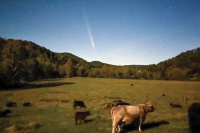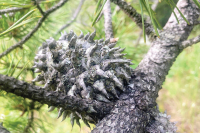Fire (ants) on the mountain: Research shows invasives species can survive cold winters
 The fire ant, S. invictus, arrived in Mobile, Alabama, in the early 1930s after it was accidentally introduced from South America. April Nobile photo
The fire ant, S. invictus, arrived in Mobile, Alabama, in the early 1930s after it was accidentally introduced from South America. April Nobile photo
Since its arrival to the United States in the early 1930s, the fire ant has been making a slow but steady march northward from the site of its initial arrival in Mobile, Alabama, but scientists had always assumed that cold winters would at some point put a stop to the tropical invasive species’ spread.
New research from Western Carolina University in Cullowhee suggests otherwise.
“The conventional wisdom had been that they just can’t handle the cold,” said Jim Costa, a coauthor on the study who holds a doctorate and is a professor in WCU’s Department of Biology. “Now we know that they can.”
Costa was one of three authors on the study. The lead author was Amanda Lytle, who earned her master’s degree in biology at WCU and is now a research technician at N.C State University. Also collaborating was Robert Warren, who is a faculty member at Buffalo State University in New York but received his master’s degree in biology from WCU. The paper was published this month in the peer-reviewed journal PLOS ONE.
The research process
Costa, an entomologist, has long had an interest in fire ants. He began noticing them around Cullowhee about 10 years ago, an observation that piqued his interest in light of that conventional wisdom about fire ants and their sensitivity to cold.
Related Items
“When I first noticed them in Cullowhee, I was curious about whether they were colonizing and staying,” he said. “I thought it was possible that colonies could get going in the spring but then the severe winters would knock them back.”
So, around 2014 he had an undergraduate study that very thing. It turned out to be a year with a harsh winter resulting from a polar vortex, making it a prime time to do the test.
“They actually survived,” said Costa.
The next question was, how? When Lytle came on as Costa’s student, she set about finding the answer using a technique Warren had developed to measure the thermal tolerance of insects. The goal was to find out if fire ants collected from warmer, low-elevation locations had a different tolerance to cold than ants collected from cooler, high-elevation locations.
During the summer of 2017, the research team collected both fire ants and native A. picea ants at three different ranges of altitude — 0 to 1,000 feet, 1,500 to 2,500 feet, and over 3,000 feet — in an area that included Clemson, South Carolina, Rabun County, Georgia, and Jackson and Macon counties in North Carolina. They collected from active, mature fire ant colonies that were at least 10 meters away from other colonies, accumulating fire ants from a total of 42 colonies scattered across the elevation gradient as well as A. picea ants from each of 21 colonies found as close to fire ant colonies as possible.
To test for temperature tolerance, ants of both species were placed in individual test tubes in a water bath. The temperature of the water was slowly lowered, and the ants were observed after each decrease of 1 degree Celsius. An ant’s cold tolerance was said to end at the point that it was unable to right itself after being flipped on its back. A different set of ants was then tested in the same way for tolerance to increasing temperatures.
“The higher-elevation ants were much more tolerant of cold conditions than the ants collected at lower elevations, so that indicated that yes, they are somehow adapting,” said Costa. “We just don’t know whether genetically or physiologically.”

Researchers prepare for fire ant collection along Chattooga Mountain Trail. Amanda Lytle photo
It could be that fire ants are shifting genetically to better tolerate the cold. Or it could be an adaptation that occurs within the body, outside of genetics — like the way that people who live in the Andes develop a greater lung capacity than people who live at more typical elevations.
“People that live at those high elevations can adapt to those conditions. It’s not a genetic change — it just reflects a kind of capacity of the body to adjust itself,” said Costa.
That question of genetic versus physiological adaptation will be the next research question to pursue, and while the plans upended by the COVID-19 pandemic include research plans, Costa hopes to continue the research once he has a student on board who’s able to do so.
Living with fire ants
In the meantime, Costa said, it’s important for land managers to be aware that fire ants aren’t a threat that can be ignored with the assumption that winter cold will control the population.
“I think the message to land managers is if we do see fire ants getting a toehold, jump on it,” he said. “Don’t let them spread, because they can survive the winter and they will multiply.”
Not without constraints, however. While the research has shown that fire ants have the ability to persist at high elevations, they need open, sunny areas to build their colonies. Because much of the higher-elevation area of Western North Carolina is heavily forested, suitable habitat for the fire ant at those heights is limited.
“It’s a fairly intact forest, and much of that is going to be unsuitable for these ants getting in and surviving,” Costa said.
Fire ants have been documented in the Great Smoky Mountains National Park since 2000, but thus far have been seen only at lower-elevation areas of the park — Chilhowee Lake, Foothills Parkway West, Cades Cove, Elkmont, Sugarlands and Gatlinburg, though Smokies Science Coordinator Paul Super said they probably exist in “many other areas” as well and could have moved into areas that managers have yet to notice.
“I have not ever seen them deep in forested areas of the park,” Super said. “The recent paper indicates that they can acclimatize to colder temperatures at higher elevations, but its important to note that they still were not observed in undisturbed forests.”
Along the Blue Ridge Parkway, there have been no recorded fire ant sightings even in the Parkway’s lower elevation areas, said spokesperson Caitlin Worth. However, that doesn’t mean there won’t be — according to Costa, the Parkway’s grassy roadsides would be “prime” fire ant habitat.
Even a small sunny area can be enough for a colony to establish. From there, the ants themselves can go foraging in the forest surrounding the sunny spot.
“They won’t go super far, but they will go in, and they’re very serious predators,” he said. “They very seriously knock back native insects.”
In addition to having an infamously nasty sting, fire ants disrupt the ecosystems they invade. They can displace native ants, and that’s a problem, because native ants are better adapted to exist in harmony with the rest of the ecosystem. For instance, said Costa, many wildflowers rely on ants to disperse their seeds. The flowers will produce seeds that have nutritious bodies attached. Ants then collect the seeds, often moving them to a new location, and eat the nutritious part while leaving the seed intact. However, some studies have shown that fire ants will devour both the nutritious bodies and the seeds themselves, inhibiting the plant’s reproduction efforts.
“Of and by themselves, these ants being here to stay is not cataclysmic, but it is one more problem that the native ecosystem faces,” said Costa.
Emerald ash border, hemlock wooly adelgid, gill lice — the list goes on. Each invasive makes life a little harder for native plant and animal communities and threatens to chip away at species diversity a little bit more.
When it comes to invasives, “the genie’s really out of the bottle,” said Costa. Global trade and movement have their virtues, but they also make the spread of nonnative species almost unavoidable. The best thing people can do, he said, is to take an active role in the one place they have some control — their own backyards.
“All we can really do is in our backyards, we can try to keep invasives at bay and try to encourage healthy ecosystems,” said Costa.













